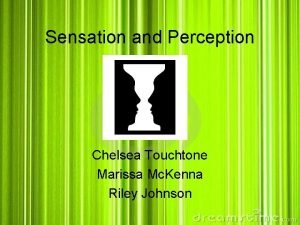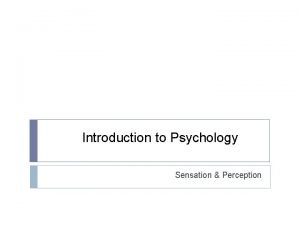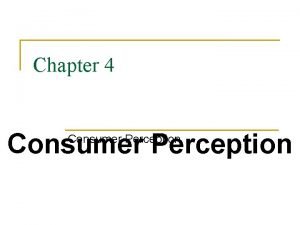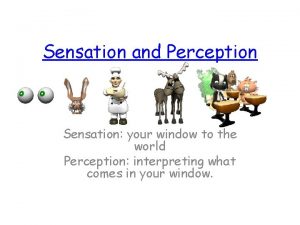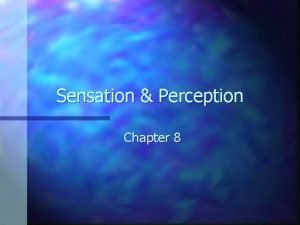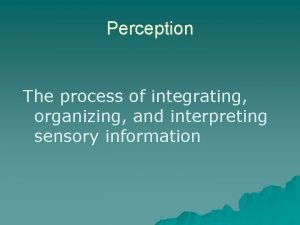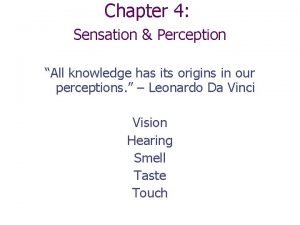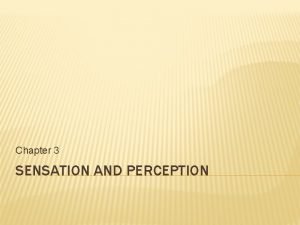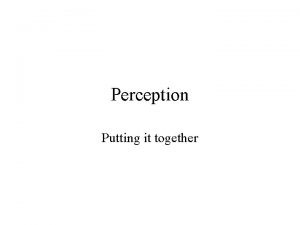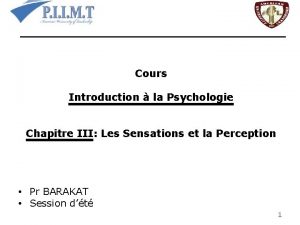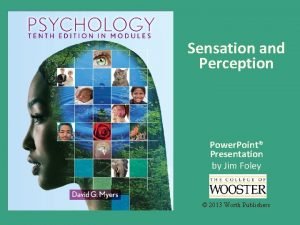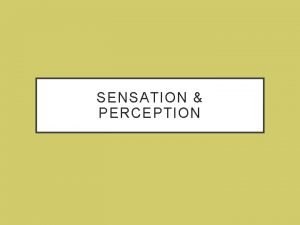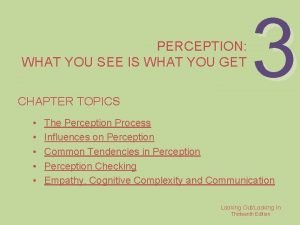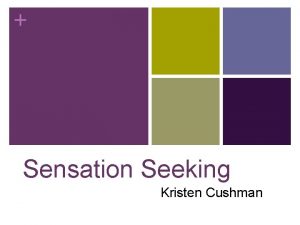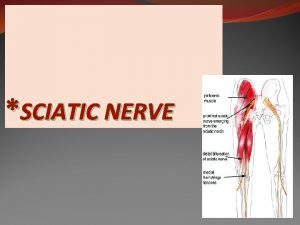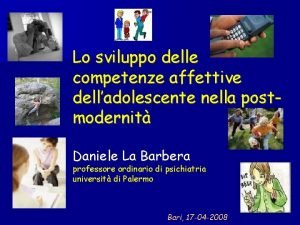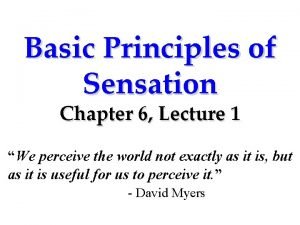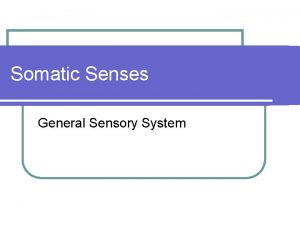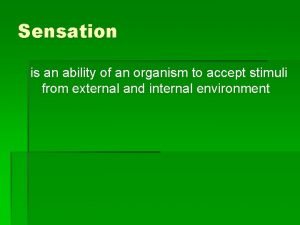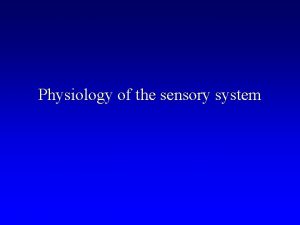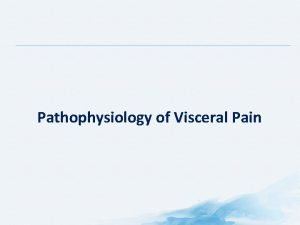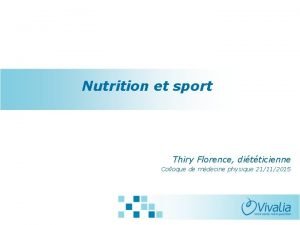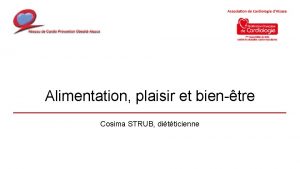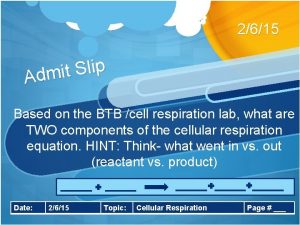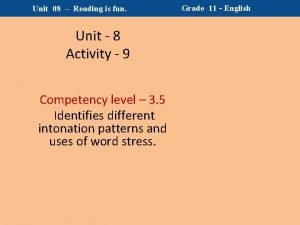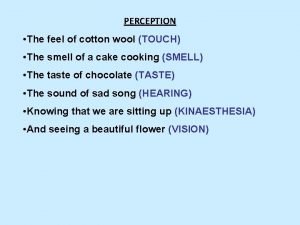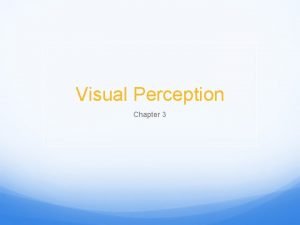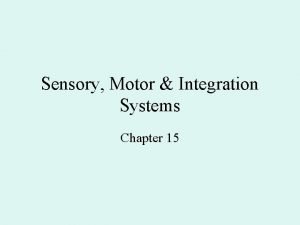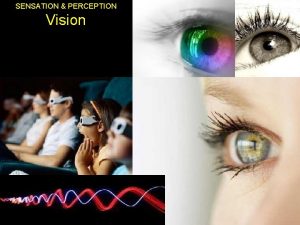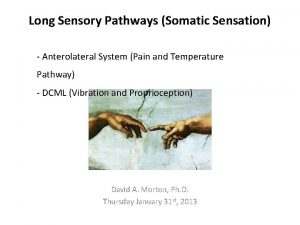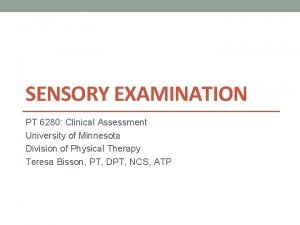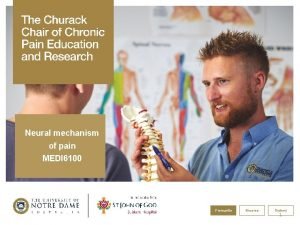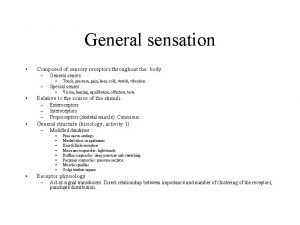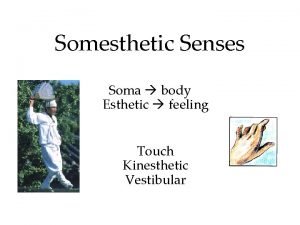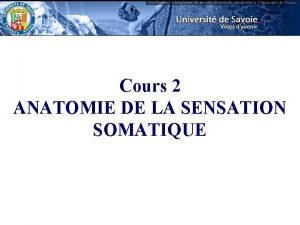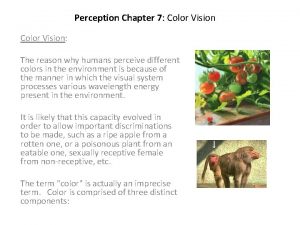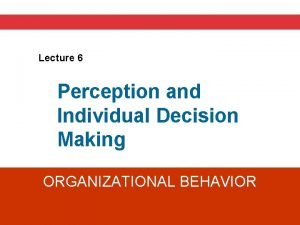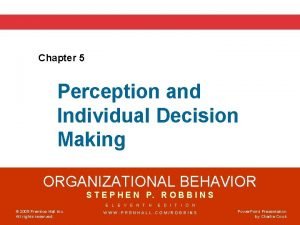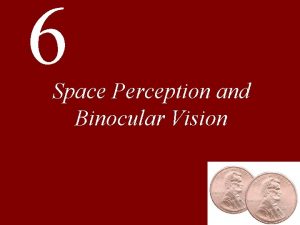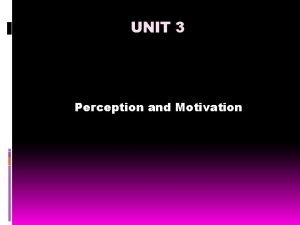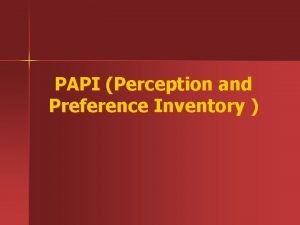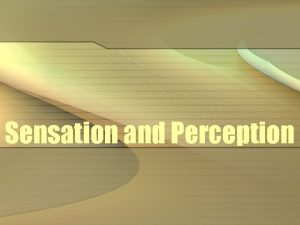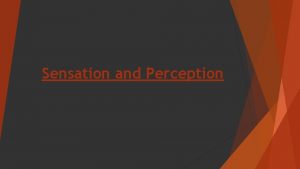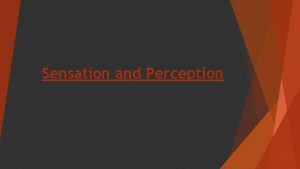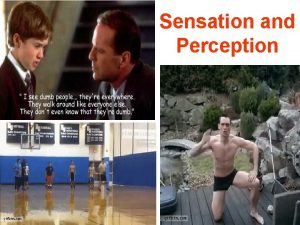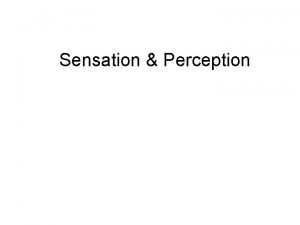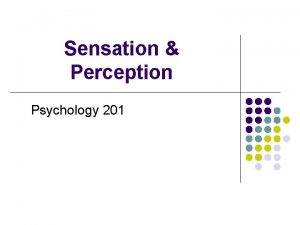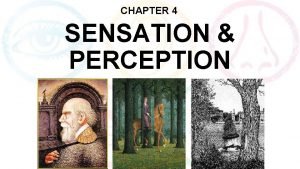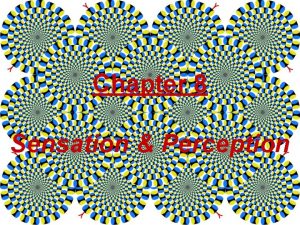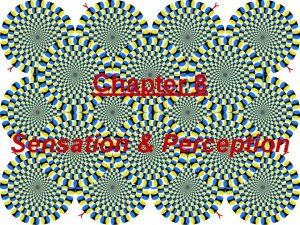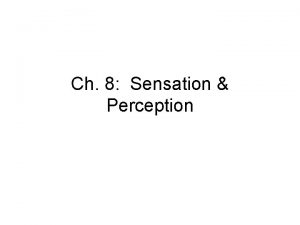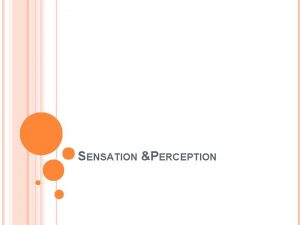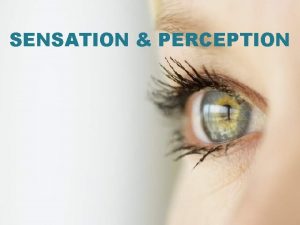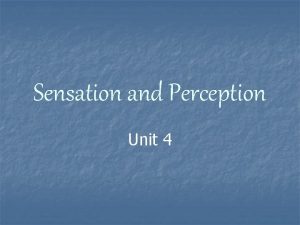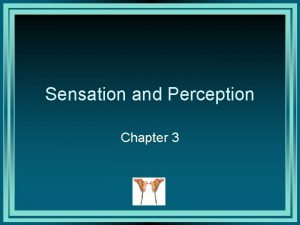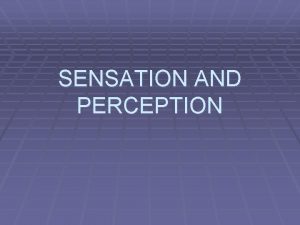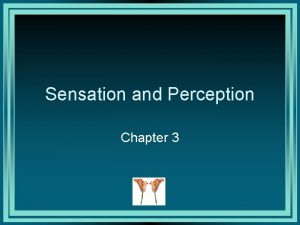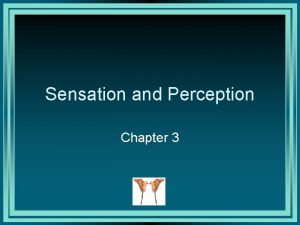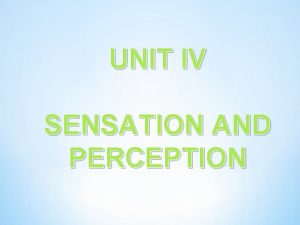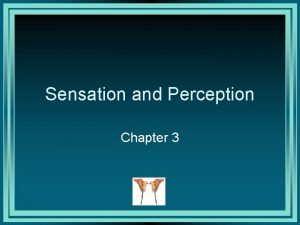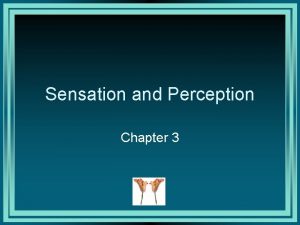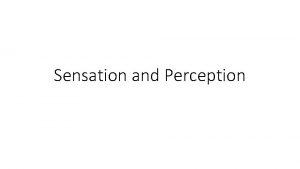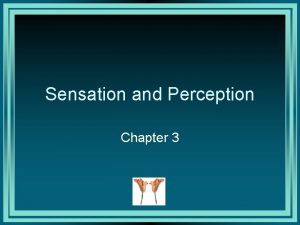SENSATION PERCEPTION OUTLINE SENSATION AND PERCEPTION 1 Define
























































- Slides: 56

SENSATION & PERCEPTION

OUTLINE: SENSATION AND PERCEPTION 1. Define key terms 2. Describe the relationship between the physical world and its psychological representation (i. e. , sensation). 3. Discuss how we use psychological representations to identify objects (i. e. , perception). • template theory • feature theory • prototype theory • Gestalt psychology 4. Distinguish between top-down and bottom-up processing. 5. Outline Gibson's 'Direct Perception' approach.

KEY TERMS Sensation – receiving physical stimulation and translating it into the electrical language of the nervous system Perception – interpreting and recognizing sensory information Key Questions: a) How do we encode information? How is a physical object in the world (distal stimulus) turned into a psychological object (proximal stimulus) in our mind/brain? b) What is the nature of the psychological representations of physical objects? c) How do we use this information to identify objects?

DISTAL V PROXIMAL STIMULI Sense Distal Stimulus Proximal Stimulus Our Perception Vision Varying pattern Pattern of neural of reflected light activity Color Audition Varying pattern Pattern of neural of air pressure activity Music Taste Medley of chemicals Pattern of neural activity Chocolate Smell Whisper of chemicals Pattern of neural activity Frying Bacon Touch Skin stretch / indentetation Pattern of neural Squeeze; Pain activity

DISTAL V PROXIMAL STIMULI Sense Distal Stimulus Proximal Stimulus Our Perception Vision Varying pattern of reflected light Pattern of neural activity Color Audition Varying pattern of air pressure Pattern of neural activity Music Taste Medley of chemicals Pattern of neural activity Chocolate Smell Whisper of chemicals Pattern of neural activity Frying Bacon Touch Skin stretch / indentetation Pattern of neural activity Squeeze; Pain Important Questions: • Can you think of any other senses? • Does food have taste? Does light have color? • Perception vs. imagery

HOW DO WE GO FROM DISTAL TO PROXIMAL? Rods Cones How many? Population of U. S. Population of N. Y. What do they react to? Movement Color When do they work best? Night Day Where are they? Periphery Center Specialization Sensitivity Acuity Why this difference in specialization? Many rods======> One ganglion One cone======> One ganglion How do they work Light bleaches photopigment that by a quasimysterious process stimulates a nerve impulse.

DISTRIBUTION OF RODS AND CONES

COLOR VISION Different types of cones respond to different wavelengths of light. Red light =====> Red cone activity Blue light =====> Blue cone activity Cones work in teams: red-green & blue-yellow Red light =====> Red cone activity

WHY AREN’T THESE KIND OF AFTERIMAGES MORE COMMON? Your eyes don’t just sit there!!! integrates information over saccade. ballistic movements that your eye makes. Why do our eyes move? Nervous system is keyed to detect changes and/or enhance boundaries

EVIDENCE THAT NERVOUS SYSTEM ENHANCES BOUNDARIES

EVIDENCE THAT NERVOUS SYSTEM ENHANCES BOUNDARIES

EVIDENCE THAT NERVOUS SYSTEM ENHANCES BOUNDARIES

CHANGE / REPETITION BLINDNESS Repetition blindness Change blindness • moviemistakes. com

CHANGE BLINDNESS COGLAB - ACCURACY 1. 00 Percent Correct 0. 80 0. 60 0. 40 0. 20 0. 00 No Flicker Condition Flicker

CHANGE BLINDNESS COGLAB - LATENCY 14000 RT 10500 7000 3500 0 No Flicker Condition Flicker

SIMONS & LEVIN (1998) Theoretical Question: • Is focused attention sufficient to detect changes to our physical environment? Empirical Question: • Will observers notice a change in appearance in a real-world, dynamic, 3 -d display? Background Literature: • People have trouble detecting changes in ‘flicker’ paradigm and ‘actor’ paradigm but… Alternative explanations: • Is CB a function of limited attention? • Central vs. peripheral information • Predictability by naïve subjects

SIMONS & LEVIN (1998): EXPERIMENT 1 Results: • Did subjects notice the change? • Age difference • Cognitive vs. social explanation

SIMONS & LEVIN (1998): EXPERIMENT 2 Results: • Did subjects notice the change? • Cognitive vs. social explanation

SIMONS & LEVIN (1998): DISCUSSION 1. What are alternative explanations for their data? • Did the social context dis/encourage reporting the change? • Locus of attention / sufficient attention 2. Which experimental phenomenon do you find more compelling / interesting: Simons and Levin (1998) or the Cog. Lab experiment? 3. If we do not retain information that is clearly in our view and that we pay attention to, why don’t we make noticeable errors more frequently? 4. What kinds of changes would you expect to be detected (or fail to be detected) in this paradigm? What does that tell us about perception?

READING RESPONSE Simons and Levin (1998) Cog. Lab (Rensink) 27 votes 5 votes Real world context Size of the data set Factors other than attention Lack of awareness Experimental Control (attention) Control of attention Experimental Control (attention)

DREW, VO, AND WOLFE (2019) Theoretical Question: • Will expertise affect inattentional blindness? Empirical Question: • Will expert radiologists be more likely to detect the presence of an anomalous figure in the context of a standard medical task? Background Literature: • Inattentional blindness is observed commonly • Generally by novices in ‘weird’ situations. • What if experts were evaluated in a task they did every day? Method: • Find the gorilla on a CT scan

DREW, VO, AND WOLFE (2019) What were the IVs and DVs? • Expertise • Eye tracking data (fixations and looking time) • Accuracy Interpretation • How did Drew, et al. (2019) deal the potential for subjects to lie? • Was there an effect of expertise? • Let’s say that you needed a radiologist to read a scan of some kind and could choose between a radiologist who was good or poor at detecting the gorilla. Which would you choose?

HOW DO WE RECOGNIZE OBJECTS IN THE ENVIRONMENT? Why is object recognition important? EX: Vermicious Knid Template Matching – Our brains store a template of every object we have ever encountered Problems: • Space Intensive • Not very fast • Not very flexible

FEATURE MODELS Recognition by Components (Biederman) • Break an image down into its constituent components, called geons • Look for edges and concave surfaces • Identify geons and their interconnections • Compare with stored representation How does this address problems with template model? • Flexibility • Space • Speed

RECOGNITION BY COMPONENTS - GEONS

FEATURE MODELS Recognition by Components (Biederman) • Break an image down into its constituent components, called geons • Look for edges and concave surfaces • Identify geons and their interconnections • Compare with stored representation How does this address problems with template model? • Flexibility • Space • Speed

EVIDENCE THAT SUPPORTS RBC – HUBEL AND WIESEL

MORE EVIDENCE TO SUPPORT RBC

MORE EVIDENCE TO SUPPORT RBC

MORE EVIDENCE TO SUPPORT RBC

FEATURE THEORIES - AGNOSIAS Agnosia – the inability to identify objects that is unrelated to problems with low-level S&P. Agnosia is an INTEGRATION problem. Ex: Can’t name what a pen is, but can use the pen to draw a picture of a pen Prosopagnosia – Inability to identify faces Emotional agnosia – inability to infer emotional states Why might the existence of agnosias be used as an argument in favor of feature theories?

PROTOYPE THEORY Guiding. Principle – Categories are organized around a “prototype” or best exemplar. Items are related by "family resemblance” • Bird or Dogs or Colors Evidence: • People are faster to verify “Robin is a bird” than “Ostrich is a bird”. • People remember "good" exemplars better than "bad" exemplars (but more false alarms, as well) Rebuttal: • Robins have more bird features than ostriches. Re-rebuttal: • Works for "colors”;

TOP-DOWN V BOTTOM-UP PROCESSING CONCEPTUAL V DATA-DRIVEN PROCESSING Top-Down: we use conceptual information to interpret the physical properties of the stimulus that in turn influences our ability to identify the object. Bottom-Up: we use the physical properties of the stimulus to determine the nature of the object. Dominant view: much of perception is Top-Down. That is, what we know affects what we see.

EVIDENCE FOR TOP-DOWN PROCESSING – AMBIGUOUS FIGURES

EVIDENCE FOR TOP-DOWN PROCESSING – SIZE CONSTANCY

EVIDENCE FOR TOP-DOWN PROCESSING – SIZE CONSTANCY

EVIDENCE FOR TOP-DOWN PROCESSING – ILLUSORY CONTOURS

TOP-DOWN PROCESSING TURNED AGAINST ITSELF – AMES ROOM

TOP-DOWN PROCESSING TURNED AGAINST ITSELF – AMES ROOM

TOP-DOWN PROCESSING TURNED AGAINST ITSELF – AMES ROOM

GESTALT PSYCHOLOGY If we use rules to make sense of the world, we should be able to specify those rules: Law of Prägnanz When in doubt, adopt the simplest possible interpretation

GESTALT PRINCIPLES

ALTERNATIVE VIEW: GIBSON’S DIRECT PERCEPTION Affordances recognize objects based on what they make available to us. Species-specific Invariants Some things about the environment do not change. These things allow us to interpret the world.

MAKING MYSELF YUGE!!!! How would you interpret the situation from the perspective of …the dominant view? • of the two explanations, one is plausible based on what we know about how the world works and one is not. …Direct perception? • The world contains many, many sources about depth cues.

MONOCULAR (ONE-EYE) DEPTH CUES Texture gradients Relative size Muller-Lyer Illusion Interposition Linear perspective (Ponzo Illusion) Motion Parallax

MONOCULAR (ONE-EYE) DEPTH CUES Texture gradients Relative size Muller-Lyer Illusion Interposition Linear perspective (Ponzo Illusion) Motion Parallax

MONOCULAR (ONE-EYE) DEPTH CUES Texture gradients Relative size Muller-Lyer Illusion Interposition Linear perspective (Ponzo Illusion) Motion Parallax

MONOCULAR (ONE-EYE) DEPTH CUES Texture gradients Relative size Muller-Lyer Illusion Interposition Linear perspective (Ponzo Illusion) Motion Parallax

MONOCULAR (ONE-EYE) DEPTH CUES Texture gradients Relative size Muller-Lyer Illusion Interposition Linear perspective (Ponzo Illusion) Motion Parallax

MONOCULAR (ONE-EYE) DEPTH CUES Texture gradients Relative size Muller-Lyer Illusion Interposition Linear perspective (Ponzo Illusion) Motion Parallax

MONOCULAR (ONE-EYE) DEPTH CUES Texture gradients Relative size Muller-Lyer Illusion Interposition Linear perspective (Ponzo Illusion) Motion Parallax

BINOCULAR (TWO-EYE) DEPTH CUES Binocular convergence • Finger sausage Binocular disparity (stereopsis) • 3 rd Eye books

KOZLOWSKI & CUTTING (1977) Identifying Gender from Point Light Displays Introduction: • Theoretical Question: • Empirical Question: Methods and Results: E 1: Is identification possible? ID was relatively easy (one outlier) E 2: Is static display sufficient? ID was difficult with static displays E 3: What did viewers use: armswing vs. speed? • Why is it important that armswing mattered more than speed?

KOZLOWSKI & CUTTING (1977) More Experiments E 4: What did viewers use: lower vs. upper joints? • Upper joints were more informative E 5: Necessary vs. sufficient • No joint was necessary; no joint was sufficient • Why is this result important? Discussion 1. Why did I have you read this article? 2. Any particular model of perception? 3. Conscious vs. unconscious processes

KOZLOWSKI & CUTTING (1977) More Discussion What are some different ways that the experimenters used failure to illuminate cognitive processes? Selected walkers with a ‘normal’ gate. Did this bias the results? Twice mentioned no feedback, why was this so important to them? Ecological validity? Who cares we never see point-light displays in our everyday environment?

PROBLEMS WITH DIRECT PERCEPTION Are affordances really specified by the environment? Circularity: • What makes a bird? • Why does a bird afford “birdyness”?
 Chapter 5 sensation and perception
Chapter 5 sensation and perception Principle of smallness
Principle of smallness Ap psych sensation and perception
Ap psych sensation and perception Perception vs sensation
Perception vs sensation Sensation and perception crossword review
Sensation and perception crossword review Chapter 3 sensation and perception
Chapter 3 sensation and perception Sensation and perception
Sensation and perception Chapter 6 sensation and perception
Chapter 6 sensation and perception Psychology chapter 4 sensation and perception
Psychology chapter 4 sensation and perception Perceptionn
Perceptionn Sensation and perception
Sensation and perception Sensation and perception
Sensation and perception Kinesthetic sense
Kinesthetic sense Sensation perception
Sensation perception Sensation and perception uu
Sensation and perception uu Chapter 4 sensation and perception
Chapter 4 sensation and perception What is sensation
What is sensation Perceptual system
Perceptual system Sensation et perception en psychologie
Sensation et perception en psychologie Perception vs sensation
Perception vs sensation Sensation vs perception
Sensation vs perception Topic sentence outline example
Topic sentence outline example Define perception
Define perception Pillow method communication
Pillow method communication Sensation seeking
Sensation seeking Branch of sciatic nerve
Branch of sciatic nerve Sensation seeking significato
Sensation seeking significato Principles of sensation
Principles of sensation Types of sensation
Types of sensation Sensation
Sensation Cortical sensation
Cortical sensation Does muscle spasms cause burning sensation
Does muscle spasms cause burning sensation Ditticienne base sur coute sensation
Ditticienne base sur coute sensation Ditticienne base sur coute sensation
Ditticienne base sur coute sensation What causes the burning sensation in your muscles
What causes the burning sensation in your muscles Vocabulary activity 8-1 sensation answer key
Vocabulary activity 8-1 sensation answer key The touch the feel of cotton
The touch the feel of cotton Sensation
Sensation Sensation
Sensation Sensation
Sensation Dcml sensation
Dcml sensation Thinking sensing feeling intuition
Thinking sensing feeling intuition Combined cortical sensation
Combined cortical sensation Pvnt neurology
Pvnt neurology Nociceptive pain
Nociceptive pain Ear sensory
Ear sensory What are the somesthetic senses
What are the somesthetic senses Sensation somatique
Sensation somatique Color vision
Color vision Preference inventory
Preference inventory Perception and individual decision making
Perception and individual decision making Concepts of health and wellbeing
Concepts of health and wellbeing Perception and individual decision making
Perception and individual decision making Subjective perception of vitality and feeling well
Subjective perception of vitality and feeling well Development of binocular vision
Development of binocular vision Motivation and perception
Motivation and perception Perception and preference inventory
Perception and preference inventory




